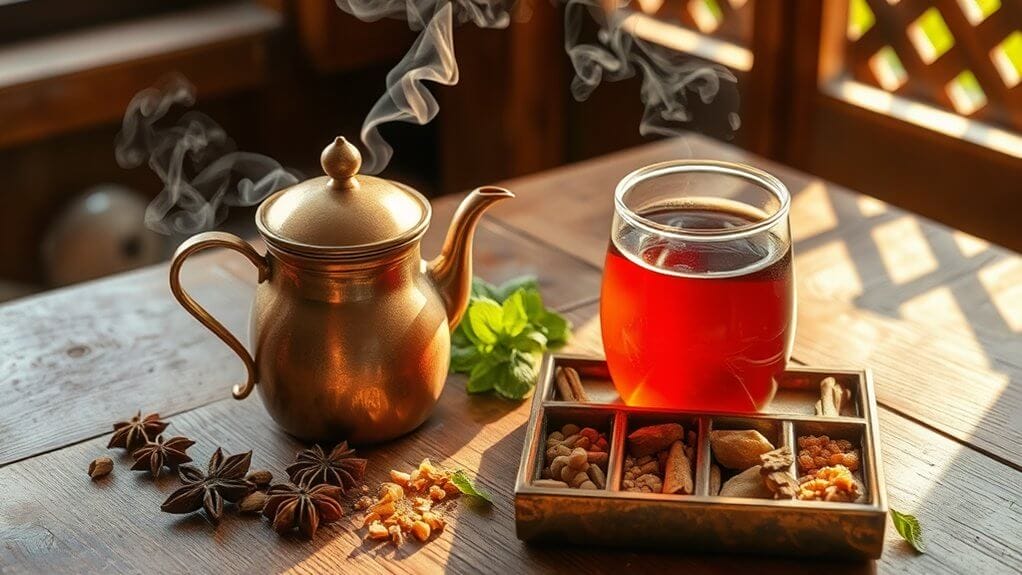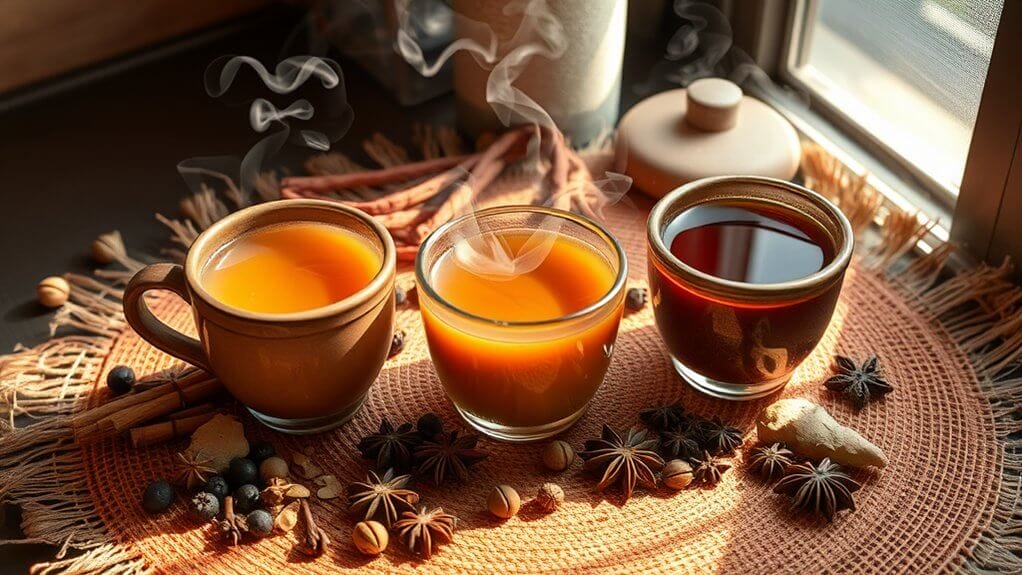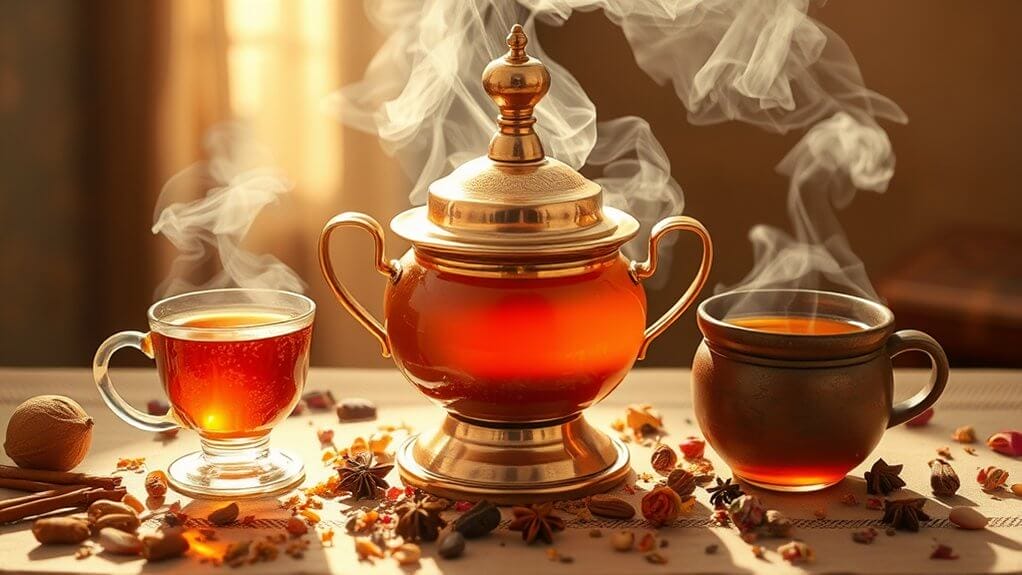India's masala chai traditions vary dramatically by region, each offering unique spice combinations and preparation methods. North Indian blends feature bold cardamom and cloves, while South Indian versions incorporate coconut milk for richness. Western India's chai balances sweet jaggery with warming spices, and Kashmir's distinctive kahwa combines green tea with saffron and rose petals. These regional variations showcase centuries of cultural adaptation, with each household's recipe telling its own story of tradition and innovation.
Key Points
- North Indian households prioritize bold spices like cardamom, cloves, ginger, and black pepper in their masala chai blends.
- Southern regions incorporate coconut milk and unique spice combinations, with variations in brewing time between 7-10 minutes.
- Western Indian households use jaggery for sweetness and include warming spices like cardamom, with Gujarati variations featuring saffron.
- Eastern regions primarily use Assam tea instead of Darjeeling, adapting spice blends for practical daily consumption.
- Kashmir Valley creates unique Kahwa blends combining green tea, saffron, dried rose petals, and regional spices in traditional brass Samovars.
The Rich Legacy of North Indian Masala Chai

While tea drinking has ancient roots in India, North Indian Masala Chai's rich legacy truly began when the British established tea farms in Assam in 1835. The introduction of black tea transformed what was originally an medicinal healing concoction used in Ayurvedic practice into today's beloved drink. Traditional preparation always includes brewing the tea in a mixture of whole milk and water, creating its signature rich texture.
The cultural significance of Masala Chai extends far beyond its origins in ancient royal courts. During India's independence movement, it emerged as a powerful symbol of unity and freedom. The Indian Tea Association's internal promotion efforts helped spread its popularity throughout the region. The rise of CTC tea production in the 1960s made the drink more accessible to the masses. Today, North Indian Masala Chai stands out for its bold, warming blend of cardamom, cloves, ginger, and black pepper, combined with strong Assam tea. This distinctive preparation method, which involves boiling rather than steeping, creates the robust flavor that's become synonymous with North Indian chai culture.
South Indian Coconut-Infused Masala Chai

Unlike its northern counterpart, South Indian Masala Chai distinguishes itself through the creative incorporation of coconut milk and unique spice combinations. The preparation involves simmering cardamom, cloves, ginger, and peppercorns with loose black tea leaves for 7-10 minutes, creating a robust brew that reflects regional preferences. Modern adaptations using unsweetened cashew milk have started gaining popularity as health-conscious households seek dairy alternatives. For added richness and wellness benefits, some enthusiasts incorporate MCT oil and butter from coconuts into their brew. The use of black peppercorns provides an invigorating warmth characteristic of South Indian chai preparations.
What sets this variation apart is its use of coconut-based ingredients. Some recipes call for rich coconut cream to achieve a luxurious texture, while others incorporate coconut oil for added depth. Spice adjustments are carefully made to complement the coconut elements, often featuring star anise and fennel seeds. The final preparation requires careful timing when adding coconut milk to prevent curdling. This beloved beverage holds deep cultural significance in South Indian households, where it's served multiple times daily and remains central to traditional hospitality.
Western India's Sweet and Spicy Brew

Moving eastward along India's coastline, Western India's masala chai presents a distinctive blend of sweet and spicy elements that sets it apart from its coconut-infused southern cousin. The traditional brewing method combines robust black tea with whole milk and a complex array of spices, creating a rich, creamy beverage that reflects regional preferences. The term masala means spice in India, perfectly describing this aromatic blend. Making chai at home allows full control over the intensity of spices and sweetness levels. This cherished beverage has been an integral part of Indian culture, where ancient royal courts first developed the practice of drinking spiced tea.
Key characteristics of Western India's masala chai include:
- Jaggery's natural sweetness, preferred over refined sugar
- A warming spice blend featuring cardamom, ginger, and black pepper
- Saffron additions in Gujarati variations for floral notes
- Whole milk's prominent role in achieving signature creaminess
The brewing process involves carefully simmering spices to release their essential oils, followed by the addition of strong black tea and whole milk. This method guarantees the perfect balance of sweet and spicy flavors that's become synonymous with Western Indian chai.
Darjeeling's Influence on Eastern Chai Blends

Nestled in the misty hills of West Bengal, Darjeeling's prized tea leaves have shaped eastern India's chai culture in unexpected ways. Despite Darjeeling Tea's global acclaim as the "Champagne of Teas," it's rarely used in traditional masala chai blends across eastern households. This exclusivity stems from its limited production, representing just 1% of India's total tea output. The tea's hand-picking tradition contributes to its high cost and limited availability. The region's Tibetan origins, reflected in its name meaning "Dorje-ling," add to its mystique and cultural significance.
While some families use lower-grade Darjeeling tea, particularly from the monsoon flush, for their chai preparations, most opt for the more readily available Assam tea. The chai nuances in eastern India reflect this practical choice, as Assam's strong flavor profile and higher yield make it better suited for daily consumption. The region's tropical plucking season from March to November ensures a steady supply for chai makers throughout most of the year. Darjeeling Tea's exceptional quality and high cost have positioned it more as a prestigious standalone beverage than a chai ingredient.
Kashmir Valley's Aromatic Green Tea Kahwa

The ancient Kashmir Valley elevates tea-drinking to an art form with its signature Kahwa, a fragrant green tea infusion that combines saffron, aromatic spices, and dried rose petals. Kahwa Rituals emphasize hospitality, with hosts carefully timing the steeping process and garnishing each cup with slivered almonds. The drink's popularity extends beyond its cultural significance to its Kahwa Health benefits, particularly during cold Himalayan winters. Modern artisanal blends incorporate five spice ingredients that deliver both flavor and wellness benefits. The traditional preparation method uses a distinctive brass Samovar kettle to achieve the perfect brew. Similar to musical performances, the preparation creates a rhythmic pattern as the host methodically stirs and pours the tea.
- Saffron and cardamom provide anti-inflammatory and digestive properties
- Traditional preparation requires precise timing to avoid bitterness
- Various regional blends incorporate local herbs and spices
- Modern tea bags offer convenience while maintaining authenticity
While traditionally served alongside Kashmiri delicacies like Rogan Josh and Gushtaba, this aromatic brew has evolved to include numerous variations, each celebrating the region's rich culinary heritage.
Global Transformation of Traditional Masala Chai

From its humble beginnings as a British colonial import, Masala Chai has undergone a remarkable global transformation that spans continents and cultures. Today's global market has embraced this aromatic beverage, with consumption growing 200% in the past decade and the U.S. market alone reaching $2.3 billion in 2023. The early use of masala chai as an ayurvedic medicine demonstrates its deep cultural roots before becoming a caffeinated beverage. The practice of adding spices emerged when local chaiwallahs began enhancing low-quality teas during British colonization.
Modern adaptations have given rise to diverse chai innovations, from Western-style chai lattes to unique regional interpretations. While international coffee chains have popularized their versions, many consumers now seek authentic preparation methods and high-quality ingredients. The evolution continues as new variations emerge, incorporating elements like green tea and specialized sweeteners such as jaggery. Despite these contemporary twists, the traditional method of brewing with milk, sugar, and carefully selected spices remains deeply rooted in Indian households and gaining appreciation worldwide.
Conclusion
Like the fabled spice routes that transformed ancient trade, India's masala chai has evolved into countless regional variations, each telling its own aromatic story. From Kashmir's saffron-kissed kahwa to Kerala's coconut-infused brews, these diverse blends have become more than just tea – they're liquid poetry in every Indian home. Today's global chai renaissance proves that, like Marco Polo's treasured discoveries, these spiced elixirs continue to enchant palates worldwide.


